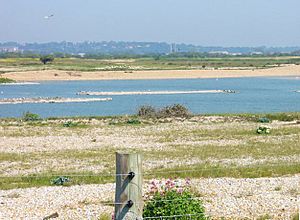Dungeness, Romney Marsh and Rye Bay facts for kids
| Site of Special Scientific Interest | |

Lake with islands in Rye Harbour Nature Reserve
|
|
| Area of Search | East Sussex Kent |
|---|---|
| Interest | Biological Geological |
| Area | 10,172.9 hectares (25,138 acres) |
| Notification | 2006 |
| Location map | Magic Map |
Dungeness, Romney Marsh and Rye Bay is a huge and very special area in England. It covers about 10,172.9 hectares (that's over 25,000 acres!) and stretches from New Romney in Kent to Winchelsea in East Sussex. This entire area is known as a Site of Special Scientific Interest (SSSI). This means it's officially protected because it has amazing wildlife, unique plants, or important geological features (like rocks and landforms).
Contents
What Makes This Place Special?
This SSSI is important for two main reasons: its incredible nature (biology) and its fascinating land history (geology). It's home to many rare and endangered animals and plants. Plus, the ground itself tells a story about how the coastline has changed over thousands of years.
Amazing Habitats
Dungeness, Romney Marsh and Rye Bay has many different types of natural environments, called habitats. These include:
- Saltmarsh: Areas of land flooded by salty water, perfect for special plants.
- Sand Dunes: Hills of sand shaped by the wind, often found near beaches.
- Vegetated Shingle: Beaches made of small, smooth stones where plants can still grow.
- Saline Lagoons: Shallow pools of salty water, often separated from the sea.
- Standing Waters: Lakes and ponds that don't flow like rivers.
- Lowland Ditch Systems: Networks of small canals or ditches in flat areas.
- Basin Fens: Wet, marshy areas with unique plants, often in bowl-shaped hollows.
These different habitats help many different species to live and thrive.
Why is it Important for Nature?
Because of its many unique habitats, this area is a haven for wildlife. It supports a wide variety of animals and plants, including some that are very rare or endangered. This means they are at risk of disappearing forever if not protected. The site helps to keep these special species safe and allows them to flourish.
A Look at the Land's History
The ground and rocks in Dungeness, Romney Marsh and Rye Bay are like an open history book. They show how the coastline has changed over time. Scientists can study these deposits to understand how the sea has moved, how land has formed, and how the environment has evolved. This makes it a very important place for studying geology.
Protecting This Area
To make sure this special place stays safe, different parts of it have extra protection:
- A large part is a Special Protection Area (SPA), which means it's very important for birds.
- Another section is a Special Area of Conservation (SAC), protecting specific habitats and species.
- A big part is also a Ramsar Site, which means it's a wetland recognized as being important around the world.
- Some areas are part of the High Weald Area of Outstanding Natural Beauty (AONB), meaning they are beautiful landscapes.
- Parts are also Geological Conservation Review sites, highlighting their importance for geology.
- You'll also find a Local Nature Reserve (LNR), managed by local councils.
- A section is a Royal Society for the Protection of Birds (RSPB) nature reserve, managed by a charity that protects birds.
- Finally, part of it is a National Nature Reserve (NNR), which are the most important sites for wildlife and geology in the UK.
All these different protections work together to keep Dungeness, Romney Marsh and Rye Bay a safe and thriving home for its amazing wildlife and a valuable place for scientists to study the Earth's history.

